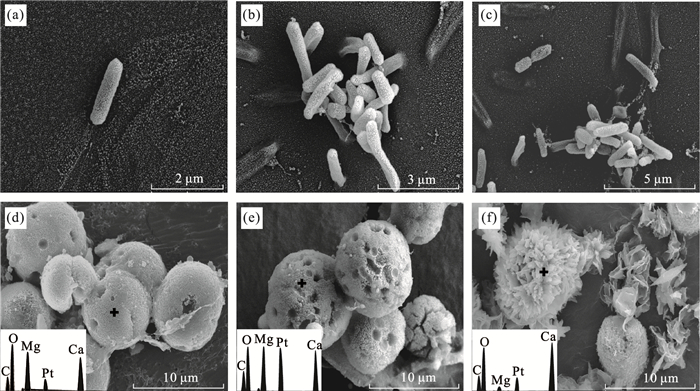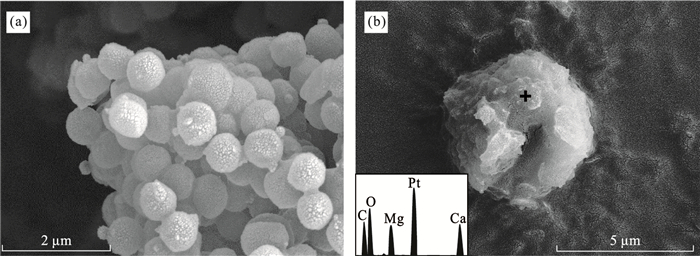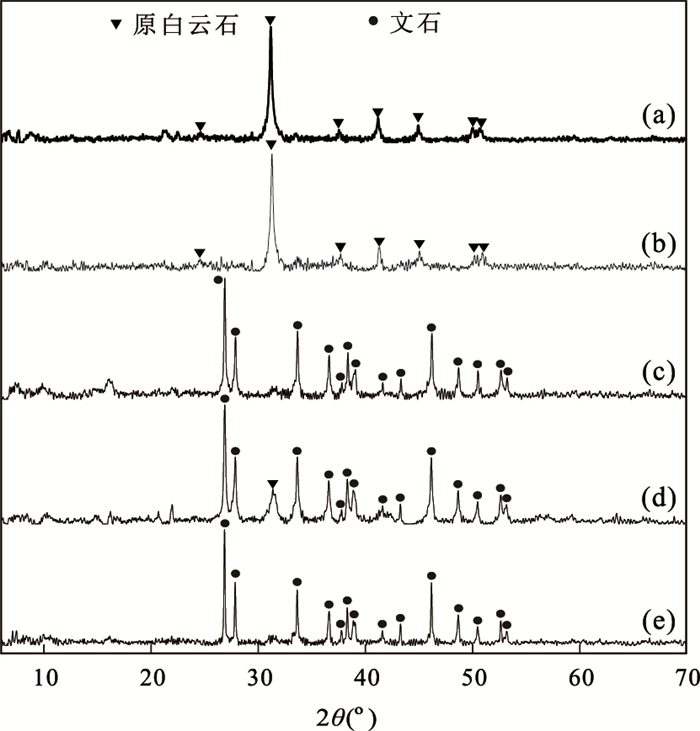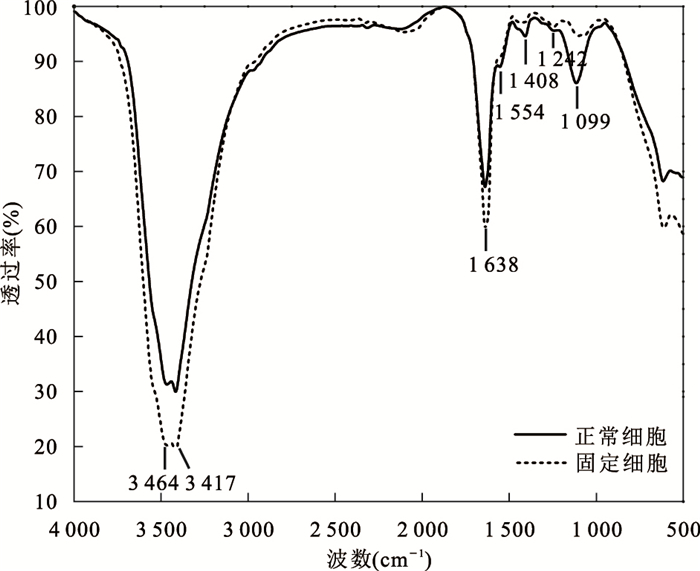Dolomite Formation Mediated by Halophilic Archaeal Cells under Different Conditions and Carboxylated Microspheres
-
摘要: 白云石是沉积岩中广泛存在的碳酸盐矿物,其成因机制一直备受关注.野外调研发现现生白云石多分布于高盐环境,模拟实验也表明嗜盐微生物能诱导形成白云石,但微生物诱导白云石沉淀的机理仍不明确.分别用嗜盐古菌Natrinema sp.J7-1对数后期的活细胞、失去代谢活性的J7-1完整细胞(经线粒体氧化磷酸化解偶联剂处理)、表面蛋白质变性的J7-1细胞(经多聚甲醛和戊二醛处理)和表面富含羧基的微球,在盐度为280‰的沉淀体系中诱导白云石沉淀.分别利用X射线衍射(XRD)分析矿物的物相,扫描电子显微镜(SEM)分析矿物、微生物以及羧基微球的形貌,傅立叶红外光谱(FT-IR)分析细胞变性前后表面的官能团.结果表明,失去代谢活性的J7-1细胞与正常的对数后期细胞均能够诱导原白云石形成;经过多聚甲醛/戊二醛固定后,细胞表面羧基含量降低,不能诱导白云石沉淀;羧基微球能够诱导形成原白云石.以上研究证实细胞表面的羧基可能是微生物促进白云石沉淀的一种关键因素,而细胞的生长代谢在本研究的条件下不是控制白云石沉淀的主要因素.Abstract: Dolomite is a widespread carbonate mineral in sedimentary rocks, and its formation mechanism have always attracted much attention. Most modern dolomite occurred in hypersaline environments and several microbial isolates from these environments have been reported to be able to induce dolomite formation as well. However the detailed mechanism of microbial induced dolomite remains largely unclear to date. In this study, a halophilic archaea, Natrinema sp. J7-1, was used to investigate what exactly played an important role in the microbial dolomite formation. Normal cells of Natrinema sp. J7-1 in post-log phase, inactive cells treated with carbonyl cyanide 3-cholorophenylhydrazine (CCCP, amitochondrial inhibitor), denatured cells treated by paraformaldehyde and glutaraldehyde, as well as carboxylated microspheres were used to induce dolomite formation. The mineral phases were identified by X-ray Diffraction(XRD), the morphologies of minerals, cells and microspheres were observed by Scanning Electron Microscope(SEM) and the functional groups on the surface of normal cells and denatured cells were analyzed by Fourier Transform Infrared Spectroscopy(FT-IR). Results showed that normal cells, inactive cells and carboxylated microspheres induced proto-dolomite formation successfully at the salinity of 280‰. In contrast, denatured cells were not capable of inducing the formation of dolomite, and the percentage of carboxyl groups on their surface decreased compared with normal cells. It can be concluded that carboxyl is one critical factor for microbially mediated dolomite formation, but respiration may count for little under our conditions.
-
Key words:
- dolomite /
- halophilic archaea /
- carboxyl /
- microorganism /
- mineralogy
-
表 1 不同处理的样品的ATP测量值
Table 1. ATP values of samples with different treatments
样品 ATP值(RLU's) A B C 平均值 无菌水 0 0 0 0 280‰洗液 0 0 0 0 细胞培养液 686 604 624 638 细胞重悬液 13 780 14 516 16 067 14 788 CCCP处理的细胞重悬液 0 0 0 0 表 2 细胞固定前后FT-IR特征峰红外波长及其对应的官能团
Table 2. The infrared wave lengths of the typical peaks on the FTIR spectra of normal cells and fixed cells and the corresponding functional groups
吸收带 波数(cm-1) 官能团 1 3 500~3 400 酰胺类化合物中的N-H伸缩振动(Benning et al., 2004) 2 ~1 638 酰胺Ⅰ峰的C=O伸缩振动(Yee et al., 2004;Tourney et al., 2008) 3 ~1 554 酰胺Ⅱ峰的N-H变形振动(Yee et al., 2004;Tourney et al., 2008) 4 ~1 400 羧基官能团中的C=O对称伸缩振动(Yee et al., 2004;Dittrich and Sibler, 2005;Heinrich et al., 2007;Leone et al., 2007) 5 ~1 242 磷酰基中的P=O非对称伸缩振动(Dittrich and Sibler, 2005) 6 1 200~900 多糖和脂类中的C-O-C,C-O-P,P-O-P振动(Dittrich and Sibler, 2005;Hadjoudja et al., 2010;Liu et al., 2015) 7 ~1 100 磷酰基中的P=O非对称伸缩振动和多糖中的C-OH伸缩振动(Jiang et al., 2004;Dittrich and Sibler, 2005) -
Adams, J.E., Rhodes, M.L., 1960.Dolomitization by Seepage Refluxion.AAPG Bulletin, 44(12):1912-1920. https://doi.org/10.1306/0bda6263-16bd-11d7-8645000102c1865d Al-Aasm, I.S., Abdallah, H., 2006.The Origin of Dolomite Associated with Salt Diapirs in Central Tunisia:Preliminary Investigations of Field Relationships and Geochemistry.Journal of Geochemical Exploration, 89(1-3):5-9. https://doi.org/10.1016/j.gexplo.2005.11.069 Albers, S.V., Meyer, B.H., 2011.The Archaeal Cell Envelope.Nature Reviews Microbiology, 9(6):414-426. https://doi.org/10.1038/nrmicro2576 Benning, L.G., Phoenix, V.R., Yee, N., et al., 2004.The Dynamics of Cyanobacterial Silicification:An Infrared Micro-Spectroscopic Investigation.Geochimica et Cosmochimica Acta, 68(4):743-757. https://doi.org/10.1016/s0016-7037(03)00488-5 Bian, Y.Y., Chen, D.F., 2014.Research Progress of Dolomite in Seep Carbonates.Bulletin of Mineralogy Petrology and Geochemistry, 33(2):238-246 (in Chinese with English abstract). http://en.cnki.com.cn/Article_en/CJFDTotal-KYDH201402013.htm Bontognali, T.R.R., McKenzie, J.A., Warthmann, R.J., et al., 2013.Microbially Influenced Formation of Mg-Calcite and Ca-Dolomite in the Presence of Exopolymeric Substances Produced by Sulphate-Reducing Bacteria.Terra Nova, 26(1):72-77. https://doi.org/10.1111/ter.12072 Bontognali, T.R.R., Vasconcelos, C., Warthmann, R.J., et al., 2010.Dolomite Formation within Microbial Mats in the Coastal Sabkha of Abu Dhabi (United Arab Emirates).Sedimentology, 57(3):824-844. https://doi.org/10.1111/j.1365-3091.2009.01121.x Deng, S.C., Dong, H.L., Lü, G., et al., 2010.Microbial Dolomite Precipitation Using Sulfate Reducing and Halophilic Bacteria:Results from Qinghai Lake, Tibetan Plateau, NW China.Chemical Geology, 278(3-4):151-159. https://doi.org/10.1016/j.chemgeo.2010.09.008 Diaz-Pulido, G., Nash, M.C., Anthony, K.R.N., et al., 2014.Greenhouse Conditions Induce Mineralogical Changes and Dolomite Accumulation in Coralline Algae on Tropical Reefs.Nature Communications, 5:3310. https://doi.org/10.1038/ncomms4310 Dittrich, M., Sibler, S., 2005.Cell Surface Groups of Two Picocyanobacteria Strains Studied by Zeta Potential Investigations, Potentiometric Titration, and Infrared Spectroscopy.Journal of Colloid and Interface Science, 286(2):487-495. https://doi.org/10.1016/j.jcis.2005.01.029 Duan, Y., Yao, Y.C., Qiu, X., et al., 2017.Dolomite Formation Facilitated by Three Halophilic Archaea.Earth Science, 42(3):389-396 (in Chinese with English abstract). https://doi.org/10.3799/dqkx.2017.029 Graziano, G., Merlino, A., 2014.Molecular Bases of Protein Halotolerance.Biochimica et Biophysica Acta (BBA)-Proteins and Proteomics, 1844(4):850-858. https://doi.org/10.1016/j.bbapap.2014.02.018 Gregg, J.M., Bish, D.L., Kaczmarek, S.E., et al., 2015.Mineralogy, Nucleation and Growth of Dolomite in the Laboratory and Sedimentary Environment:A Review.Sedimentology, 62(6):1749-1769. https://doi.org/10.1111/sed.12202 Hadjoudja, S., Deluchat, V., Baudu, M., 2010.Cell Surface Characterisation of Microcystis Aeruginosa and Chlorella Vulgaris.Journal of Colloid and Interface Science, 342(2):293-299. https://doi.org/10.1016/j.jcis.2009.10.078 Heinrich, H.T.M., Bremer, P.J., Daughney, C.J., et al., 2007.Acid-Base Titrations of Functional Groups on the Surface of the Thermophilic BacteriumAnoxybacillusflavithermus:Comparing a Chemical Equilibrium Model with ATR-IR Spectroscopic Data.Langmuir, 23(5):2731-2740. https://doi.org/10.1021/la062401j Hendry, J.P., Gregg, J.M., Shelton, K.L., et al., 2014.Origin, Characteristics and Distribution of Fault-Related and Fracture-Related Dolomitization:Insights from Mississippian Carbonates, Isle of Man.Sedimentology, 62(3):717-752. https://doi.org/10.1111/sed.12160 Huang, S.J., Huang, K.K., Lv, J., et al., 2014.The Relationship between Dolomite Textures and Their Formation Temperature:ACase Study from the Permian-Triassic of the Sichuan Basin and the Lower Paleozoic of the Tarim Basin.Petroleum Science, 11(1):39-51. https://doi.org/10.1007/s12182-014-0316-7 Jiang, W., Saxena, A., Song, B., et al., 2004.Elucidation of Functional Groups on Gram-Positive and Gram-Negative Bacterial Surfaces Using Infrared Spectroscopy.Langmuir, 20(26):11433-11442. https://doi.org/10.1021/la049043+ Kenward, P.A., Fowle, D.A., Goldstein, R.H., et al., 2013.Ordered Low-Temperature Dolomite Mediated by Carboxyl-Group Density of Microbial Cell Walls.AAPG Bulletin, 97(11):2113-2125. https://doi.org/10.1306/05171312168 Kenward, P.A., Goldstein, R.H., González, L.A., et al., 2009.Precipitation of Low-Temperature Dolomite from an Anaerobic Microbial Consortium:The Role of Methanogenic Archaea.Geobiology, 7(5):556-565. https://doi.org/10.1111/j.1472-4669.2009.00210.x Land, L.S., 1998.Failure to Precipitate Dolomite at 25℃ fromDilute Solution Despite 1000-Fold Oversaturation after 32 Years.Aquatic Geochemistry, 4(3-4):361-368. https://doi.org/10.1023/a:1009688315854 Leone, L., Ferri, D., Manfredi, C., et al., 2007.Modeling the Acid-Base Properties of Bacterial Surfaces:A Combined Spectroscopic and Potentiometric Study of the Gram-Positive Bacterium Bacillus Subtilis.Environmental Science & Technology, 41(18):6465-6471. https://doi.org/10.1021/es070996e Li, B., Yan, J.X., Liu, X.T., et al., 2010.The Organogenic Dolomite Model:Mechanism, Progress and Significance.Journal of Palaeogeography, 12(6):699-710 (in Chinese with English abstract). http://en.cnki.com.cn/Article_en/CJFDTOTAL-GDLX201006009.htm Li, H., Liu, Y.Q., 2013."Dolomite Problem" and Research of Ancient Lacustrine Dolostones.Acta Sedimentologica Sinica, 31(2):302-314 (in Chinese with English abstract). http://en.cnki.com.cn/Article_en/CJFDTOTAL-CJXB201302009.htm Li, H., Liu, Y.Q., Li, W.H., et al., 2013.The Microbial Precipitation of Lacustrine Dolomite from Permian Formation, Urumchi, Xinjiang, China.Geological Bulletin of China, 32(4):661-670 (in Chinese with English abstract). http://en.cnki.com.cn/Article_en/CJFDTOTAL-ZQYD201304015.htm Liu, Y.X, Alessi, D.S., Owttrim, G.W., et al., 2015.Cell Surface Reactivity of Synechococcus Sp.PCC 7002:Implications for Metal Sorption from Seawater.Geochimica et Cosmochimica Acta, 169:30-44. https://doi.org/10.1016/j.gca.2015.07.033 Mckenzie, J.A., Vasconcelos, C., 2009.Dolomite Mountains and the Origin of the Dolomite Rock of WhichThey Mainly Consist:Historical Developments and New Perspectives.Sedimentology, 56(1):205-219. https://doi.org/10.1111/j.1365-3091.2008.01027.x Mei, M.X., 2012.Brief Introduction of "Dolostone Problem" in Sedimentology according to Three Scientific Ideas.Journal of Palaeogeography, 14(1):1-12 (in Chinese with English abstract). http://en.cnki.com.cn/Article_en/CJFDTOTAL-GDLX201201003.htm Mei, Y.J., He, C.C., Huang, Y.C., et al., 2015.Salinity Regulation of the Interaction of Halovirus SNJ1 with Its Host and Alteration of the Halovirus Replication Strategy to Adapt to the Variable Ecosystem.PLoS ONE, 10(4):e0123874. https://doi.org/10.1371/journal.pone.0123874 Qiu, X., Wang, H.M., Liu, D., et al., 2012.The Physiological Response ofSynechococcusElongatusto Salinity:A Potential Biomarker for Ancient Salinity in Evaporative Environments.Geomicrobiology Journal, 29(5):477-483. https://doi.org/10.1080/01490451.2011.581331 Ries, J.B., 2010.Review:Geological and Experimental Evidence for Ssecular Variation in Seawater Mg/Ca(Calcite-Aragonite Seas) and Its Effects on Marine Biological Calcification.Biogeosciences, 7(9):2795-2849. https://doi.org/10.5194/bg-7-2795-2010 Rivers, J.M., Kurt Kyser, T., James, N.P., 2012.Salinity Reflux and Dolomitization of Southern Australian Slope Sediments:The Importance of Low Carbonate Saturation Levels.Sedimentology, 59:445-465. https://doi.org/10.1111/j.1365-3091.2011.01260.x Roberts, J.A., Bennett, P.C., González, L.A., et al., 2004.Microbial Precipitation of Dolomite in Methanogenic Groundwater.Geology, 32(4):277-280. https://doi.org/10.1130/g20246.2 Roberts, J.A., Kenward, P.A., Fowle, D.A., et al., 2013.Surface Chemistry Allows for Abiotic Precipitation of Dolomite at Low Temperature.Proceedings of the National Academy of Sciences of the United States of America, 110(36):14540-14545. https://doi.org/10.1073/pnas.1305403110 Sánchez-Román, M., McKenzie, J.A., de Luca Rebello Wagener, A., et al., 2009.Presence of Sulfate Does Not Inhibit Low-Temperature Dolomite Precipitation.Earth and Planetary Science Letters, 285(1-2):131-139. https://doi.org/10.1016/j.epsl.2009.06.003 Saum, S.H., Sydow, J.F., Palm, P., et al., 2006.Biochemical and Molecular Characterization of the Biosynthesis of Glutamine and Glutamate, Two Major Compatible Solutes in the Moderately Halophilic Bacterium Halobacillus Halophilus.Journal of Bacteriology, 188(19):6808-6815. https://doi.org/10.1128/jb.00781-06 Sleytr, U.B., Schuster, B., Egelseer, E.M., et al., 2014.S-Layers:Principles and Applications.FEMS Microbiology Reviews, 38(5):823-864. https://doi.org/10.1111/1574-6976.12063 Sumper, M., Berg, E., Mengele, R., et al., 1990.Primary Structure and Glycosylation of the S-Layer Protein of Haloferax Volcanii.Journal of Bacteriology, 172(12):7111-7118. https://doi.org/10.1128/jb.172.12.7111-7118.1990 Tourney, J., Ngwenya, B.T., Fred Mosselmans, J.W., et al., 2008.The Effect of Extracellular Polymers (EPS) on the Proton Adsorption Characteristics of the Thermophile Bacillus licheniformis S-86.Chemical Geology, 247(1-2):1-15. https://doi.org/10.1016/j.chemgeo.2007.09.012 van Lith, Y., Vasconcelos, C., Warthmann, R., et al., 2002.Bacterial Sulfate Reduction and Salinity:Two Controls on Dolomite Precipitation in Lagoa Vermelha and Brejo do Espinho (Brazil).Hydrobiologia, 485:35-49. https://doi.org/10.1023/A:1021323425591 Vasconcelos, C., McKenzie, J.A., 1997.Microbial Mediation of Modern Dolomite Precipitation and Diagenesis under Anoxic Conditions (Lagoa Vermelha, Rio de Janeiro, Brazil).Journal of Sedimentary Research, 67(3):378-390.https://doi.org/1073-130x/97/067-0378 Vasconcelos, C., McKenzie, J.A., Bernasconi, S., et al., 1995.Microbial Mediation as a Possible Mechanism for Natural Dolomite Formation at Low Temperatures.Nature, 377(6546):220-222. https://doi.org/10.1038/377220a0 Voegerl, R. S., 2014. Quantifying the Carboxyl Group Density of Microbial Cell Surfaces as a Function of Salinity: Insights Into Microbial Precipitation of Low-Temperature Dolomite (Dissertation). University of Kansas, Lawrence. Wang, D.B., Wallace, A.F., De Yoreo, J.J., et al., 2009.Carboxylated Molecules Regulate Magnesium Content of Amorphous Calcium Carbonates during Calcification.Proceedings of the National Academy of Sciences of the United States of America, 106(51):21511-21516. https://doi.org/10.1073/pnas.0906741106 Wang, H.M., Wu, X.P., Qiu, X., et al., 2013.Microbially Induced Carbonate Precipitation:A Review.Microbiology China, 40(1):180-189 (in Chinese with English abstract). http://en.cnki.com.cn/Article_en/CJFDTotal-WSWT201301020.htm Wang, W.W., Tang, H.Z., Xu, P., 2015.Salt-Tolerance Related Genes in Halophilic Bacteria andArchaea.Microbiology China, 42(3):550-558(in Chinese with English abstract). Wang, X.L., Chou, I.M., Hu, W.X., et al., 2016.Kinetic Inhibition of Dolomite Precipitation:Insights from Raman Spectroscopy of Mg2+-SO42- Ion Pairing in MgSO4/MgCl2/NaCl Solutions at Temperatures of 25 to 200℃.Chemical Geology, 435:10-21. https://doi.org/10.1016/j.chemgeo.2016.04.020 Wang, Y., 2006.Dolomite Problem and Precambrian Enigma.Advances in Earth Science, 21(8):857-862(in Chinese with English abstract). Warren, J., 2000.Dolomite:Occurrence, Evolution and Economically Important Associations.Earth-Science Reviews, 52(1-3):1-81. https://doi.org/10.1016/s0012-8252(00)00022-2 Warthmann, R., Vasconcelos, C., Sass, H., et al., 2005.Desulfovibrio BrasiliensisSp.Nov., a Moderate Halophilic Sulfate-Reducing Bacterium from Lagoa Vermelha (Brazil) Mediating Dolomite Formation.Extremophiles, 9(3):255-261. https://doi.org/10.1007/s00792-005-0441-8 Wright, D.T., 1999.The Role of Sulphate-Reducing Bacteria and Cyanobacteria in Dolomite Formation in Distal Ephemeral Lakes of the Coorong Region, South Australia.Sedimentary Geology, 126(1-4):147-157. https://doi.org/10.1016/s0037-0738(99)00037-8 Xia, W.J., Li, X.H., 1986.The Discorvery of Primary Dolomitefrom Beach Rockin the Xiaochaidan Salt Lake of QingHai and Its Significance.Acta Sedimentologica Sinica, 4(2):19-25(in Chinese with English abstract). http://en.cnki.com.cn/Article_en/CJFDTOTAL-CJXB198602001.htm Yee, N., Benning, L.G., Phoenix, V.R., et al., 2004.Characterization of Metal-Cyanobacteria Sorption Reactions:A Combined Macroscopic and Infrared Spectroscopic Investigation.Environmental Science & Technology, 38(3):775-782. https://doi.org/10.1021/es0346680 Xie, S.C., Liu, D., Qiu, X., et al., 2016.Microbial Roles Equivalent to Geological Agents of High Temperature and Pressure in Deep Earth.Science China Earth Science, 59(11):2098-2104. https://doi.org/10.1007/s11430-015-5442-1 You, X.L., Sun, S., Zhu, J.Q., et al., 2011.Progress in the Study of Microbial Dolomite Model.Earth Science Frontiers, 18(4):52-64 (in Chinese with English abstract). http://en.cnki.com.cn/Article_en/CJFDTOTAL-DXQY201104004.htm Yu, B.S., Dong, H.L., Jiang, H.C., et al., 2007.Discovery of Spheric Dolomite Aggregations in Sediments from the Bottom of Qinghai Lake and Its Significance for Dolomite Problem.Geoscience, 21(1):66-70(in Chinese with English abstract). http://en.cnki.com.cn/Article_en/CJFDTotal-XDDZ200701006.htm Zhang, F.F., Xu, H.F., Konishi, H., et al., 2010.A Relationship between d104 Value and Composition in the Calcite-Disordered Dolomite Solid-Solution Series.American Mineralogist, 95(11-12):1650-1656. https://doi.org/10.2138/am.2010.3414 Zhang, F.F., Xu, H.F., Konishi, H., et al., 2012a.Polysaccharide-Catalyzed Nucleation and Growth of Disordered Dolomite:A Potential Precursor of Sedimentary Dolomite.American Mineralogist, 97(4):556-567. https://doi.org/10.2138/am.2012.3979 Zhang, Z.Q., Liu, Y., Wang, S., et al., 2012b.Temperate Membrane-Containing Halophilic Archaeal Virus SNJ1 Has a Circular dsDNA Genome Identical to that of Plasmid pHH205.Virology, 434(2):233-241. https://doi.org/10.1016/j.virol.2012.05.036 Zhang, X.F., Hu, W.X., Zhang, J.T., 2006.Critical Problems for Dolomite Formation and Dolomitization Models.Geological Science and Technology Information, 25(5):32-40 (in Chinese with English abstract). http://en.cnki.com.cn/Article_en/CJFDTOTAL-DZKQ200605005.htm 卞友艳, 陈多福, 2014.海底冷泉环境中的白云石(岩)研究现状.矿物岩石地球化学通报, 33(2):238-246. http://kns.cnki.net/KCMS/detail/detail.aspx?filename=kydh201402013&dbname=CJFD&dbcode=CJFQ 段勇, 药彦辰, 邱轩, 等, 2017.三株嗜盐古菌诱导形成白云石.地球科学, 42(3):389-396. https://doi.org/10.3799/dqkx.2017.029 李波, 颜佳新, 刘喜停, 等, 2010.白云岩有机成因模式:机制, 进展与意义.古地理学报, 12(6):699-710. http://kns.cnki.net/KCMS/detail/detail.aspx?filename=gdlx201006009&dbname=CJFD&dbcode=CJFQ 李红, 柳益群, 2013."白云石(岩)问题"与湖相白云岩研究.沉积学报, 31(2):302-314. http://kns.cnki.net/KCMS/detail/detail.aspx?filename=cjxb201302009&dbname=CJFD&dbcode=CJFQ 李红, 柳益群, 李文厚, 等, 2013.新疆乌鲁木齐二叠系湖相微生物白云岩成因.地质通报, 32(4):661-670. http://kns.cnki.net/KCMS/detail/detail.aspx?filename=zqyd201304015&dbname=CJFD&dbcode=CJFQ 梅冥相, 2012.从3个科学理念简论沉积学中的"白云岩问题".古地理学报, 14(1):1-12. http://kns.cnki.net/KCMS/detail/detail.aspx?filename=gdlx201201003&dbname=CJFD&dbcode=CJFQ 王红梅, 吴晓萍, 邱轩, 等, 2013.微生物成因的碳酸盐矿物研究进展.微生物学通报, 40(1):180-189. http://kns.cnki.net/KCMS/detail/detail.aspx?filename=wswt201301020&dbname=CJFD&dbcode=CJFQ 王伟伟, 唐鸿志, 许平, 2015.嗜盐菌耐盐机制相关基因的研究进展.微生物学通报, 42(3):550-558. http://kns.cnki.net/KCMS/detail/detail.aspx?filename=wswt201503016&dbname=CJFD&dbcode=CJFQ 王勇, 2006."白云岩问题"与"前寒武纪之谜"研究进展.地球科学进展, 21(8):857-862. http://kns.cnki.net/KCMS/detail/detail.aspx?filename=dxjz200608010&dbname=CJFD&dbcode=CJFQ 夏文杰, 李秀华, 1986.青海小柴旦盐湖湖滩岩中原生白云石的发现及其意义.沉积学报, 4(2):19-25. http://kns.cnki.net/KCMS/detail/detail.aspx?filename=cjxb198602001&dbname=CJFD&dbcode=CJFQ 由雪莲, 孙枢, 朱井泉, 等, 2011.微生物白云岩模式研究进展.地学前缘, 18(4):52-64. http://kns.cnki.net/KCMS/detail/detail.aspx?filename=dxqy201104004&dbname=CJFD&dbcode=CJFQ 于炳松, 董海良, 蒋宏忱, 等, 2007.青海湖底沉积物中球状白云石集合体的发现及其地质意义.现代地质, 21(1):66-70. http://kns.cnki.net/KCMS/detail/detail.aspx?filename=xddz200701006&dbname=CJFD&dbcode=CJFQ 张学丰, 胡文瑄, 张军涛, 2006.白云岩成因相关问题及主要形成模式.地质科技情报, 25(5):32-40. http://kns.cnki.net/KCMS/detail/detail.aspx?filename=dzkq200605005&dbname=CJFD&dbcode=CJFQ -










 下载:
下载:




